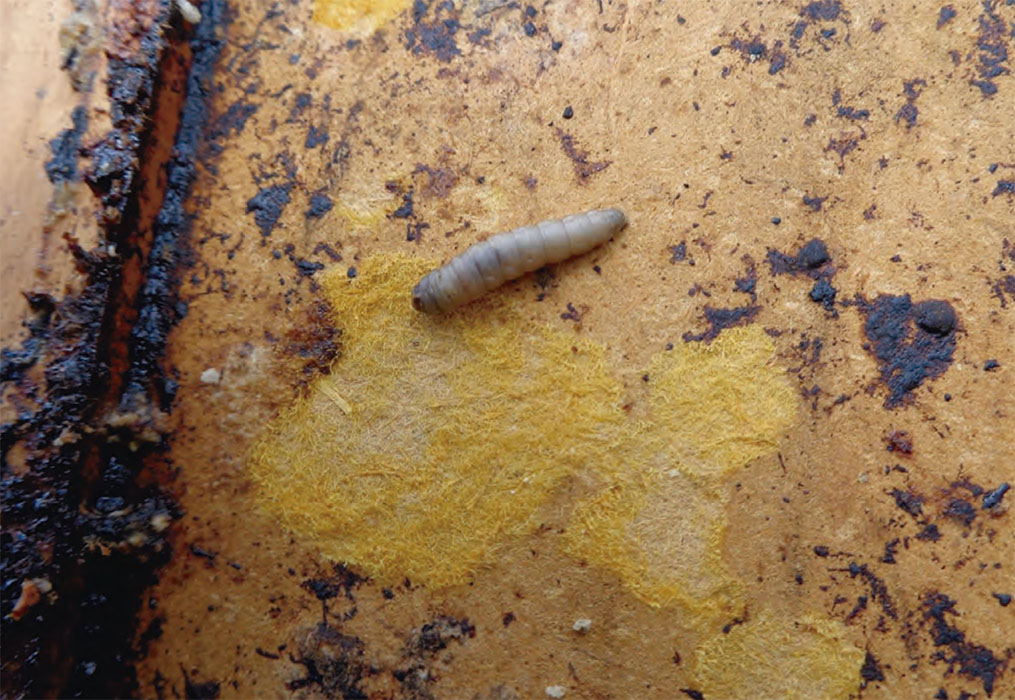Wax moth control
Abstract
The common Galleria mellonella moth is a lepidopteran insect that is distributed worldwide. It is a butterfly, which in its larval stage becomes one of the biggest pests of bees Apis mellifera, which strongly impacts beekeepers, not only because of the damage it causes to bees, but also the damage generated to the wax, given that feeds on it. (Photo 1).
The adult moth has a longevity of one week and the females place the eggs (200 to 1,000), in the grooves of the hives, which prevents the bees from being able to remove or eliminate them. The oviposition rate is higher when there is a density of up to 150 pairs of moths (Realpe-Aranda et al., 2007). Adults do not feed on wax because their oral apparatus is atrophied, it is the larvae that consume wax and pollen, building galleries, spreading a kind of silk inside and on the surface, spreading their feces in the pictures and rendering them totally useless. . The growth speed is directly proportional to the temperature and the amount of food available, the weight of larvae can double daily in the first 10 days (Charrière and Imfort, 1999). To this end, Realpe-Aranda et al. (2007) determined that at 30oC the egg cycle lasts 62 days and 182 days at 20oC and concluded that 25oC is the best temperature to breed the common moth.
References
Brighenti D. M., C.F. Carvalho, C.R.G. Brighenti y S.M. Carvalho. 2004. Perda de cera em favos de Apis mellifera Linnaeus, 1758 (Hymenoptera: Apidae) por Galleria mellonella (Linnaeus, 1758) e Achroia grisella (Fabricius, 1794) In: XII Congresso Brasileirde Entomologia. Gramado. RS, Brasil. 695 p.
Brighenti D.M., C.F. Carvalho, G.A. Carvalho y C.R.G.Brighenti. 2005. Eficiência do Bacillus thuringiensis var. kurstaki (Berliner, 1915) no controle da traça da cera Galleria mellonella (Linnaeus, 1758) (Lepidoptera:Pyralidae). Ciência e Agrotecnologia, Lavras. 29 (1): 60-68 pp.
Couto R.H.N. y L.A. Couto. 1996. Apicultura: Manejo e produtos. Ed. FUNEP, Jaboticabal, SP, Brasil. 154 p. Charrière J.D. y A. Imdorf. 1999. Protection of honey combs from wax moth damage. American-Bee-Journal, 139 (8):627-630 pp.
Fernández-Larrea O. 2007. Bacillus thuringiensis. Principales características. Aislamiento. Producción y Métodos de trabajo. Instituto Nacional de Investigaciones Agrícolas (INIA). Instituto de Investigaciones de Sanidad Vegetal de Cuba (INISAV). Mérida, Venezuela. 180 p.
Mendoça P.C. 2002. Caracterização e sequenciamento dos plasmídeos pMC1 e pMC2 de Bacillus thuringiensis var. thuringiensis isolado T01 328. Dissertação (Mestrado em Agronomia/ Genética e Melhoramento de Plantas). Universidade do Estado de São Paulo (UNESP), Jaboticabal, São Paulo. 53 p.
Realpe-Aranda F.C., A.E. Bustillo-Pardey y J.C. López-Núñez. 2007. Optimización de la cría de Galleria mellonella (L.) para la producción de nematodos entomopatógenos parásitos de la broca del café. Cenicafé 58(2): 142-157 pp.
Vandenberg J.D., y H. Shimanuki. 1990. Viability of Bacillus thuringiensis and its efficacy for larvae of the greater wax moth (Lepidoptera:Pyralidae) following storage of treated combs. Journal of Economic Entomology. 83(3): 760-765 pp.


